What to do if Compaq Armada M700 diskette is write-protected?
- JJames HarrisonSep 23, 2025
Use another diskette that is not write-protected or disable the write-protect feature.

What to do if Compaq Armada M700 diskette is write-protected?
Use another diskette that is not write-protected or disable the write-protect feature.
What to do if my Compaq Laptop shows a hard disk error?
If your Compaq Laptop displays a hard disk failure or error, it means there was a problem accessing the hard drive. Run ScanDisk to attempt to resolve this issue.
How to fix corrupt time/date on Compaq Laptop?
If the time and date are corrupt on your Compaq Laptop, it's possible there was a power loss. Run Computer Setup to resolve this.
How to fix hard disk controller error on Compaq Armada M700?
If you get a hard disk controller error on your Compaq Laptop, the hard drive controller isn't responding to the reset command. Check the drive parameters, turn off the system, and check all related connections.
How to fix Compaq Armada M700 when drive cannot read a disc?
If your Compaq Laptop drive cannot read a disc, the disc might not be properly seated in the drive. Open the loading tray, insert the disc, and then close the tray.
What to do if disc is upside down in Compaq Armada M700?
If the disc is loaded upside down in your Compaq Laptop, open the loading tray, turn over the disc (label facing up), and then close the tray.
What to do if Compaq Armada M700 has faulty refresh circuits?
If your Compaq Laptop has faulty refresh circuits, a continuous read/write test of port found that bit failed to toggle within an allotted amount of time. Replace the system board.
How to fix interrupt controller failure on Compaq Armada M700?
If the interrupt controller failed on your Compaq Laptop, a sequential read/write of various Interrupt Controller registers failed. Replace the system board.
What to do if Compaq Armada M700 Laptop drive cannot write to diskette?
If your Compaq Laptop drive cannot write to a diskette, the diskette might not be formatted. Format the diskette to resolve this.
Why is my Compaq Laptop keyboard not working?
If the keyboard on your Compaq Laptop fails to respond to the RESET ID command, replace the keyboard. If the problem continues, replace the system board.
Details the components and functions of the pointing stick and touchpad.
Identifies and describes the function of various components on the top of the computer.
Identifies and describes the function of various components on the left side of the computer.
Identifies and describes the function of various components on the right side of the computer.
Identifies and describes the function of various components on the front of the computer.
Identifies and describes the function of various components on the rear panel of the computer.
Identifies and describes the function of various components on the bottom of the computer.
Illustrates and identifies standard components included with most computer models.
Explains how to use the pointing stick and touchpad for cursor control.
Details procedures for moving and interacting with the pointer using pointing devices.
Describes how to configure preferences for the pointing device.
Explains how to use the Fn key in combination with other keys for special functions.
Introduces preset key combinations for frequently used system functions.
Details how to toggle the display output between internal and external screens.
Explains how to adjust the computer's system volume using hotkeys.
Describes how to activate Quick Controls for enhanced security.
Explains how to set power conservation levels using hotkeys.
Details how to view battery status using hotkeys.
Explains how to adjust screen brightness using hotkeys.
Describes how to display system hardware and software information.
Explains how to stretch text to fill the screen using a hotkey.
Explains how to use programmable buttons for quick access to Internet or network items.
Details the process for creating a new scheme for Easy Access Button assignments.
Describes how to modify button names or assignments within an existing scheme.
Explains how to view and change the active Easy Access Button scheme.
Details the process for removing an Easy Access Button scheme.
Explains how to toggle and use the embedded numeric keypad.
Describes how to configure the computer to start with the numeric keypad enabled.
Explains the locations supported for battery packs in the computer and docking base.
Provides guidelines for properly storing battery packs to maintain their condition.
Details the procedure for replacing a discharged battery pack with a charged one.
Provides step-by-step instructions for removing the main battery from its bay.
Provides step-by-step instructions for inserting the main battery into its bay.
Details how to remove a battery pack from the computer's MultiBay.
Details how to insert a battery pack into the computer's MultiBay.
Explains the available power sources for the computer and their usage scenarios.
Describes the energy-saving features of Suspend and Hibernation modes.
Explains how to identify and resolve low-battery and critical low-battery conditions.
Provides instructions on how to charge a battery pack using external power sources.
Explains how to increase accuracy of battery charge displays and use quick check.
Explains the process of calibrating battery packs to improve charge display accuracy.
Describes how to adjust power usage by setting preferences for performance and timeouts.
Details power preference settings specific to the Windows 95 operating system.
Details power preference settings specific to the Windows 98 operating system.
Details power preference settings specific to the Windows NT 4.0 operating system.
Details power preference settings specific to Windows 2000 Professional.
Explains how to disable auto insert notification for CD-ROM/DVD-ROM drives.
Explains how Intel SpeedStep technology adjusts processor speed for performance or battery life.
Describes how to configure SpeedStep performance modes and related settings.
Provides practices and settings to maximize battery operating time.
Provides essential precautions for handling and maintaining computer drives safely.
Identifies the three bays available for installing computer drives.
Describes the use of the weight saver as a replacement for a MultiBay device.
Covers the installation and removal procedures for hard drives.
Provides step-by-step instructions for removing the hard drive from its bay.
Provides step-by-step instructions for inserting the hard drive into its bay.
Details how to insert a hard drive into its MultiBay adapter.
Details how to remove a hard drive from its MultiBay adapter.
Provides instructions for inserting the hard drive assembly into the MultiBay.
Provides instructions for removing the hard drive assembly from the MultiBay.
Covers the installation and removal of CD-ROM and DVD-ROM drives.
Details the procedure for removing CD-ROM or DVD-ROM drives from the MultiBay.
Details the procedure for inserting CD-ROM or DVD-ROM drives into the MultiBay.
Explains how to insert a disc into a CD-ROM or DVD-ROM drive.
Explains how to remove a disc from a CD-ROM or DVD-ROM drive.
Covers the installation and removal of diskette and SuperDisk LS-120 drives.
Details removing diskette or SuperDisk LS-120 drives from the MultiBay.
Details inserting diskette or SuperDisk LS-120 drives into the MultiBay.
Explains how to use a diskette drive externally via an assembly.
Provides instructions for removing a diskette drive from its external bay.
Provides instructions for inserting a diskette drive into its external bay.
Explains how to insert a diskette into a compatible drive.
Explains how to remove a diskette from a compatible drive.
Explains how to change the computer's startup sequence using MultiBoot.
Describes how to enable MultiBoot and change the startup sequence via utilities.
Details how to modify the startup sequence through Computer Setup.
Details how to modify the startup sequence via Compaq Computer Security.
Provides a quick overview of security features to protect against various risks.
Offers guidance on actions to take if a password is forgotten.
Explains the use of Computer Setup and Compaq Computer Security utilities for security.
Details the function and use of a power-on password for computer security.
Describes procedures for managing power-on passwords in various utilities.
Explains how to set a power-on password using Compaq Computer Security.
Introduces Quick Controls features like QuickLock for enhanced security.
Details how to configure Quick Controls preferences within Computer Setup.
Details how to configure Quick Controls preferences within Compaq Computer Security.
Explains the function and use of setup or administrator passwords for system configuration.
Describes procedures for managing setup/administrator passwords.
Explains how DriveLock prevents unauthorized access to hard drive contents.
Provides detailed steps for enabling DriveLock protection on a hard drive.
Explains how to disable drives, ports, and other devices for limited user access.
Details how to enable or disable devices via the Computer Setup utility.
Details how to enable or disable devices via Compaq Computer Security.
Explains how to display and manage system identification information.
Provides instructions for connecting the internal modem to a telephone line.
Details the procedures for setting up the modem in various Windows versions.
Explains how to use preinstalled or optional software for modem communication.
Explains how to configure the modem using AT commands.
Provides guidance for using the modem internationally, including adapter use.
Details how to connect the modem using a country-specific adapter.
Explains how to change the modem's country selection setting for compliance.
Offers suggestions for troubleshooting modem connection problems when traveling.
Provides instructions for reinstalling or updating modem drivers for Win 95/98.
Provides instructions for reinstalling or updating modem drivers for Win NT 4.0.
Provides instructions for reinstalling or updating modem drivers for Win 2000 Pro.
Details the steps for connecting the computer to a Local Area Network.
Explains how to conserve power by turning the LAN connection on and off.
Describes how to connect to PXE or RPL servers during computer startup.
Provides instructions for updating modem and LAN drivers for Win 95/98.
Details how to uninstall modem and LAN drivers for Win 95/98.
Provides instructions for reinstalling LAN and modem drivers for Win 95/98.
Explains how to verify network protocol settings after driver reinstallation.
Provides instructions for updating modem and LAN drivers for Win NT 4.0.
Details how to uninstall modem and LAN drivers for Win NT 4.0.
Provides instructions for reinstalling Windows NT Networking components.
Details installing or restoring LAN drivers for Windows 2000 Professional.
Details installing or restoring modem drivers for Windows 2000 Professional.
Explains how to view RAM, increase it with expansion boards, and manage hibernation file space.
Provides safety precautions and procedures for installing/removing memory boards.
Details the steps required to remove the keyboard to access memory slots.
Provides step-by-step instructions for removing a memory expansion board.
Provides step-by-step instructions for inserting a memory expansion board.
Provides instructions for reinstalling the computer keyboard.
Describes the internal microphone and stereo speakers and their usage.
Explains how to connect external audio devices to the computer's jacks.
Helps in selecting the correct audio connector for different devices.
Provides guidance on connecting devices to the microphone jack.
Provides guidance on connecting devices to the stereo speaker/headphone jack.
Explains how to adjust system volume using keyboard hotkeys.
Explains how to connect external video devices to the computer.
Details connecting video devices to the composite video-out jack.
Explains how to change the color television standard mode.
Guides users on accessing help files for setting video preferences.
Provides instructions for installing CardWare software for PC Cards on Windows NT 4.0.
Describes the two PC Card slots and the types of cards they support.
Explains how to configure PC Cards, including precautions for installing drivers.
Provides step-by-step instructions for inserting a PC Card into a slot.
Provides step-by-step instructions for safely removing a PC Card.
Explains IrDA compliance and infrared communication capabilities.
Provides default settings and configuration tips for the infrared port.
Details how to enable the infrared port in Windows 95 and Windows 98.
Provides guidelines for optimal positioning of infrared ports for transmission.
Provides detailed configuration and diagnostic information for system assets.
Prevents, predicts, and alerts to impending hardware problems.
Protects unauthorized access to work, system information, and components.
Provides the latest drivers, utilities, and software for system configuration.
Guides users on setting up Insight Management Agents.
Explains how to identify and set preferences for fault management alerts.
Introduces the two system management utilities: Computer Setup and Compaq Diagnostics.
Explains how to access and use the Computer Setup utility for system configuration.
Details options available within the File menu of Computer Setup.
Details options available within the Security menu of Computer Setup.
Details options available within the Advanced menu of Computer Setup.
Explains how to use Compaq Diagnostics for system information and testing.
Guides users on how to get, save, or print configuration information.
Guides users on how to get, save, or print diagnostic test information.
Recommends installing software updates and describes how to obtain them.
Explains how to get update information and software from the Compaq website.
Provides instructions for downloading software updates from the Compaq website.
Details the process for installing downloaded software updates.
Explains how to restore operating system and language software.
Provides guidelines for maintaining the computer's physical condition.
Details steps for preparing the computer for shipping or travel.
Offers a checklist of precautions for traveling with the computer.
Provides a checklist of common solutions for system problems.
Offers solutions for common audio issues with the computer.
Provides solutions for common problems related to battery operation.
Offers solutions for common issues with CD-ROM and DVD-ROM drives.
Provides solutions for common problems with diskette and LS-120 drives.
Offers solutions for common issues related to hard drive operation.
Provides solutions for common issues with infrared communication.
Offers solutions for common keyboard and numeric keypad issues.
Provides solutions for common modem connectivity and performance issues.
Offers solutions for common issues encountered with PC Cards.
Provides solutions for common computer power-related issues.
Offers solutions for common issues related to the computer display.
Provides solutions for common issues with USB connected devices.
Explains how to access personal technical support via the Compaq Web site.
Lists information needed to receive the fastest possible solution from technical support.
Provides a table of worldwide telephone numbers for Compaq customer support.
Explains agency series numbers used for product identification and approval.
Details FCC compliance for Class B digital devices and interference correction measures.
Outlines basic safety precautions for using modems and telephones.
Explains FCC Part 68 compliance, including Ringer Equivalence Number (REN).
Details CE marking compliance with EU directives for telecommunications equipment.
Provides methods to discharge static electricity before handling components.
Describes how to discharge static electricity before handling drives.
Provides guidance on handling internal components to prevent ESD damage.
Details various grounding methods to prevent electrostatic discharge.
Provides the physical dimensions of the computer in U.S. and metric units.
Lists the operating and non-operating conditions for temperature and humidity.
Details the electrical input power ratings for the computer.
Lists port addresses, IRQ, and DMA settings for various computer ports.
Provides technical specifications for the internal modem.


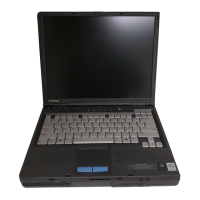
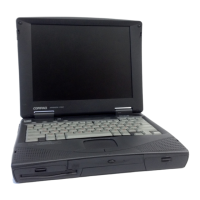


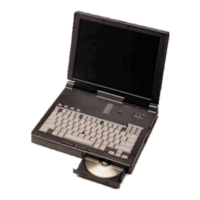


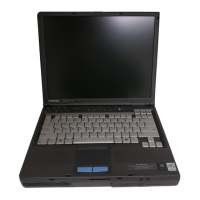

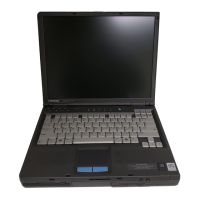
